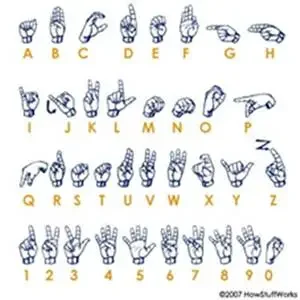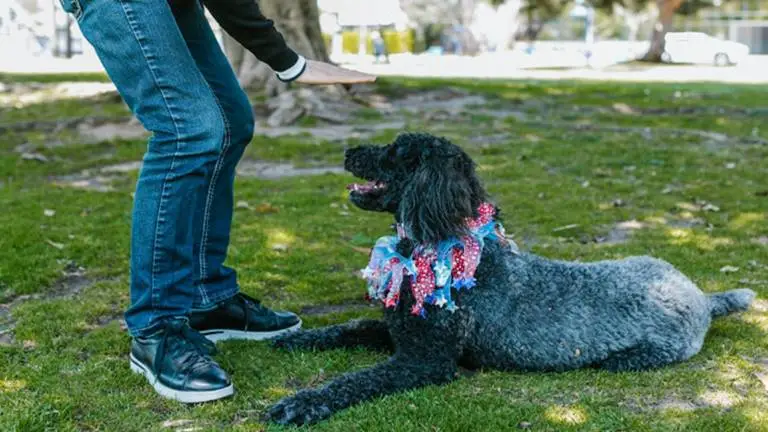If you’ve ever wondered how to train a deaf dog, you’re not alone. Training a deaf dog is no different than training any other pup. It just takes a bit more patience and understanding! With the right training techniques and a strong bond, you and your deaf dog can learn to thrive together.
You will not only be able to help your pup navigate their world, but you will also develop a deeper understanding and appreciation for one another.
Is it possible to train a deaf dog?
Absolutely! While it may seem daunting at first, training a deaf pup is no more difficult than training any other pup. With proper guidance and patience, you can have your deaf dog obeying commands in no time. Here’s what you need to know about deaf dog training.
Getting Your Deaf Dog Attention
Prior to asking a pooch to do something, you must acquire its focus. Since you can’t shout its name like you can with a hearing canine, you must discover other techniques to gain your dog’s concentration. A few actions you can take to make a deaf dog focus on you include stomping your foot on the ground. Occasionally the vibrations passing through the floor will be sufficient to make your dog turn its attention in your direction.
Training with Sign Language

The most common method for training a deaf dog is using sign language. Deaf dog hand signals are an effective way to communicate with your furry friend without relying on verbal commands. Start simple by teaching basic signs like “sit,” “stay,” and “come.” Make sure to keep your body language consistent as this will help your pup learn the commands faster. Move slowly and deliberately when showing the signs so that your pup has enough time to process the information.
Utilize Visual Cues
In addition to hand signals, visual cues such as flags or lights can be used to help get your pup’s attention and indicate desired behaviors. Flags are especially helpful; they provide an easily identifiable cue that can be seen from far away, unlike deaf dog hand signals which may become less visible at a distance. You can also use lights or vibrations as cues; just make sure they are consistent every time so that your pup knows what is expected of them.
A prevalent blunder that numerous dog owners commit is not speaking while they give their non-verbal instructions. Just since your deaf pup can’t listen to you doesn’t mean you ought to stay quiet; regularly your non-verbal communication can look unnatural if you give a direction silently.
To guarantee the visual directions come normally to you and decipher effectively to your canine, really articulate the words of a command as you play out the activity.
Surprise Training
Although your deaf pup can detect your arrival through vibrations in the ground, they can’t hear you arriving and may be shocked when you contact them or abruptly appear. This can be an even bigger worry for those pups who lose their hearing later in life since they can no longer count on the aural signals they once did. Since any pup can bite when scared, it’s essential to acclimate your dog and teach them that being astonished is a positive and can result in rewards.
Vibrating Collars
Another effective way in deaf dog training is through vibrating collars. Deaf dog training collars emit vibrations whenever you press a button on the remote control; these vibrations act as physical cues that alert your pup to specific commands. This method is especially useful if you want to reinforce certain behaviors in public settings where hand gestures may not be seen or understood by everyone around you. Additionally, vibrating collars can help reduce anxiety in dogs who have difficulty processing sound.
Caution: Avoid using shock collars on your dog at all costs.
Positive Reinforcement
Positive reinforcement is key when teaching any canine behavior and this is especially true when dealing with a deaf pup. Since they cannot hear verbal praise or commands, you should reward them with treats or toys whenever they successfully complete a task or command you have given them using visual cues or flashlights. Make sure to give plenty of verbal praise as well so that your pup knows he has done something good even if he cannot hear it!
This will help reinforce good habits and encourage him to continue obeying commands in the future as well as build trust between you both.
Get Creative With Rewards
Rewards are essential when teaching any pup new skills! With deaf dogs, treats may not always be effective because they won’t hear you giving praise or encouragement during training sessions. Try using toys instead! Toys can be used to reward good behavior in lieu of treats, allowing for more interactive and fun learning experiences for you and your pup!
Read more:
Why Do Dogs Eat Dead Bees?
Patience
Deaf dog training takes patience – lots of it! Remember that every pup is different and some may pick up on commands faster than others (just like humans!). So don’t get discouraged if it takes longer than expected for your pup to understand what you want from them – keep practicing with them every day and eventually they will get it!
Also remember that training should be fun for both you and your pup – if it starts feeling too overwhelming or stressful for either one of you, take a break! That will help relieve any tension that has built up during training sessions so you can come back refreshed and ready to start again.
Create Structure
Creating structure and consistency with your deaf pup is also essential; it helps them feel secure and sets boundaries for their behavior. Establish routines for mealtimes, walks, playtime, and bedtime; being consistent with these will give your pup structure and make it easier for them to learn new things.
You Aren’t Alone in Your Journey
If you ever find yourself stuck on how best to train your deaf pup, there are resources out there that can help. Professional trainers who specialize in working with deaf dogs are available if needed, as well as books and online blogs dedicated to teaching pet owners how best to train their pups without hearing aids or verbal cues.
There are also specialized groups that offer support specifically for those who own deaf dogs; these groups are especially helpful if you ever feel overwhelmed with the task at hand or just need some advice from someone who has been through what you’re going through now.
Leash Your Deaf Dogs for Safety
Many individuals relish going on strolls with their pooches that are not on a leash. It’s open to debate if this is ever a smart move yet it’s certainly never a good thought to let your hearing-impaired pup roam free in unfenced territories.
Since even the best trained dog can be easily sidetracked, you cannot rely on a return order or a quick recall to shield your deaf dog from a hazardous circumstance. Keeping them on a leash is the safest option for your pup.
Wrap Up
Teaching deaf dogs poses a unique challenge for dog owners, as traditional methods of training and communication cannot be used. Dogs that are deaf rely on visual cues, so owners must establish and use a different form of communication to get their point across. Many owners find that using hand signals is an effective way to communicate with their deaf dogs. This can involve pointing to objects, using specific hand gestures, or teaching the dog to respond to a light.
In addition to learning hand signals, owners must also take the time to train their deaf dog in basic obedience. This can include teaching commands such as sit, stay, and come. In order to do this, owners should use treats and positive reinforcement to encourage their dog to learn the commands. The key is to be patient and consistent when teaching the dog, as it may take time for them to learn the new commands.
Finally, pet owners must also be aware of the safety issues that come with having a deaf dog. Since they cannot hear a car approaching or other potential hazards, it is important to take extra precautions when walking them. This may include keeping them on a leash at all times, or having them wear a deaf dog training collar with a light that can alert others to their presence.
Good Luck!


